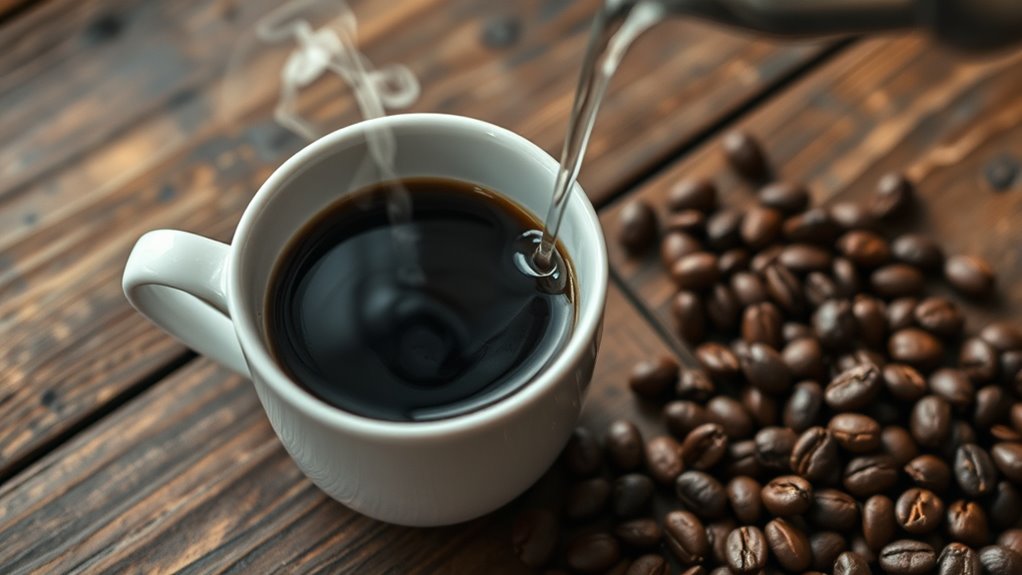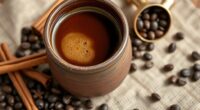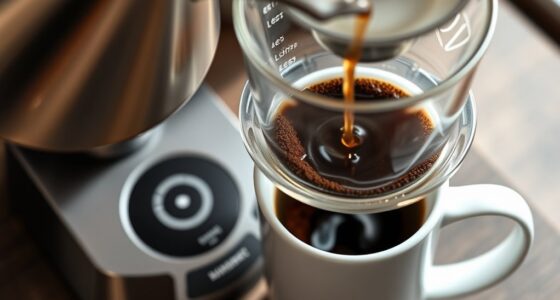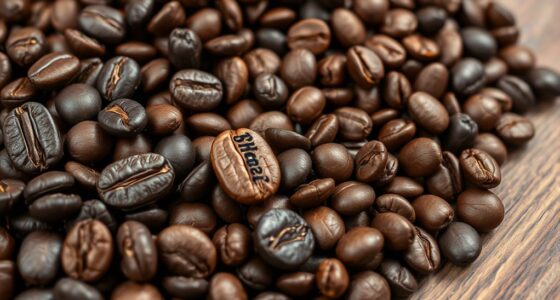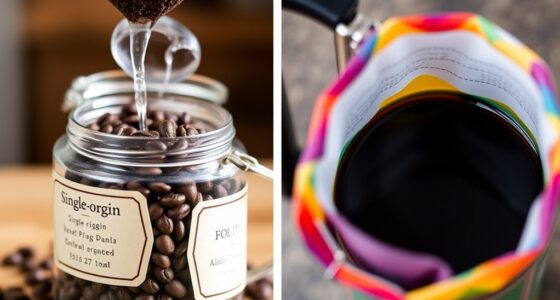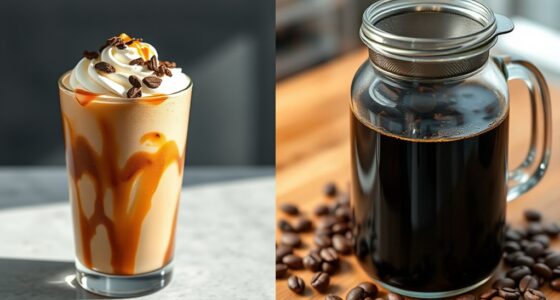To brew strong coffee without bitterness, start by choosing beans from regions like Ethiopia or Colombia, which offer vibrant flavors. Use a medium to coarse grind and make certain your brewing temperature stays between 195°F and 205°F to prevent over-extraction. Preheat your equipment and avoid boiling water. Carefully control brew time to balance strength and flavor, avoiding bitterness and sourness. Keep these tips in mind, and you’ll discover how to craft a smooth, potent cup every time.
Key Takeaways
- Use beans from bold, earthy regions like Sumatra or Brazil for a stronger flavor profile.
- Brew at a consistent temperature between 195°F and 205°F to prevent bitterness and ensure proper extraction.
- Preheat brewing equipment to maintain steady heat and avoid temperature drops that can cause harsh flavors.
- Opt for medium to coarse grind size to promote even extraction and prevent over-extraction bitterness.
- Avoid over-brewing by controlling brew time, ensuring a strong yet smooth cup without bitterness.
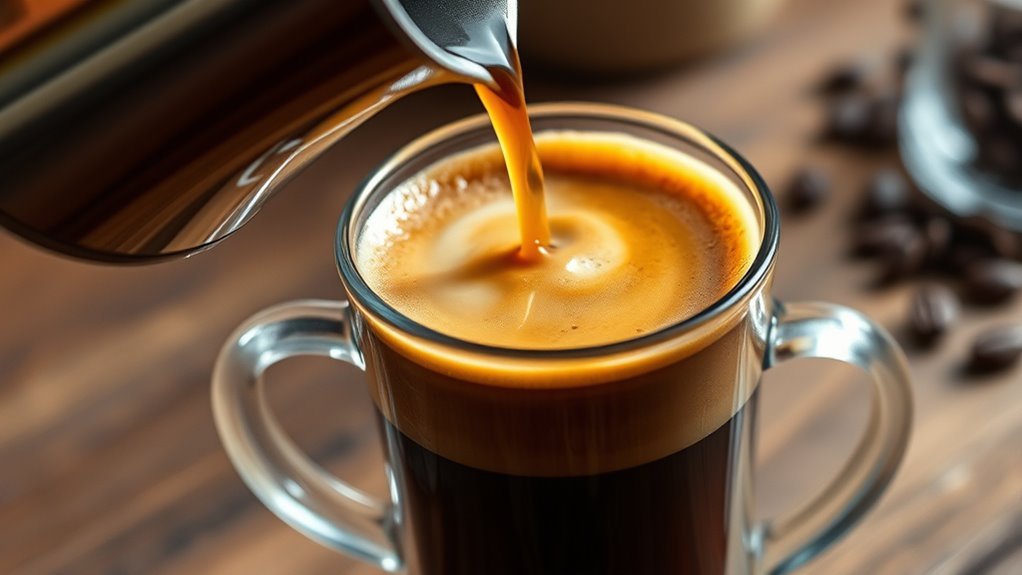
Are you looking to brew a cup of truly strong coffee? If so, understanding the importance of coffee bean origin and brewing temperature can make all the difference. The origin of your coffee beans influences their flavor profile, acidity, and strength. Beans from regions like Ethiopia or Colombia tend to have vibrant, fruity notes, while those from Sumatra or Brazil are often bolder and earthier. Choosing the right beans for your desired strength means selecting a variety that naturally has a more robust and intense flavor. Once you’ve picked your beans, their origin will guide how you approach brewing. Additionally, maintaining the proper brewing temperature is essential to extracting maximum flavor without introducing bitterness. Typically, the ideal temperature range is between 195°F and 205°F. Too hot, and you’ll risk extracting bitter compounds; too cool, and your coffee may taste weak or sour. Ensuring your brewing water is within this perfect temperature range allows the rich oils and flavors to dissolve fully, resulting in a strong, smooth cup. Using a temperature-controlled brewing device can help maintain consistent heat throughout the process, preventing undesirable flavors.
When preparing your coffee, consider the grind size as well. For brewing methods aiming for strength, a medium to coarse grind usually works best, allowing water to extract flavors evenly without overdoing it. If you’re using a drip machine, set it to an appropriate temperature, and ensure the water heats up to the recommended range. For manual pour-over or French press, preheat your equipment and use hot, not boiling, water to avoid extracting harsh flavors. The key is consistency; maintaining a steady brewing temperature throughout the process ensures you don’t over-extract or under-extract your coffee. Over-extraction, often caused by too high a temperature or prolonged brewing, results in bitterness, which you want to avoid. Under-extraction, from too low a temperature or insufficient brewing time, produces a weak, insipid brew. Finding that sweet spot between temperature and time helps you craft a strong cup without the undesirable bitter notes. Proper temperature control is crucial for optimizing flavor extraction and avoiding bitterness.
Frequently Asked Questions
Can Water Temperature Affect Coffee Bitterness?
Yes, water temperature affects coffee bitterness because it influences water chemistry and flavor extraction. If water’s too hot, it can over-extract compounds, making your coffee bitter. Conversely, too cool water under-extracts flavors, resulting in weak taste. Ideally, keep water around 195-205°F to balance extraction and enhance flavor without bitterness. Adjusting temperature helps you control water chemistry, ensuring a smoother, more flavorful cup.
Does Grind Size Impact the Strength and Bitterness?
Irony hits—you think a finer grind means more strength, but it’s actually the opposite. Your grind size directly impacts coffee’s strength and bitterness, so inconsistent grind consistency ruins the flavor. Opting for grind optimization guarantees uniform extraction, preventing over-bitter, weak, or overly strong brews. When you focus on a consistent grind, you control the flavor profile, delivering a balanced, strong cup without the unwanted bitterness.
Are There Specific Coffee Bean Types Less Bitter?
Certain coffee bean varieties naturally have milder flavor profiles and are less bitter, such as Arabica beans. You’ll find they tend to be smoother and more balanced, making them ideal if you want less bitterness. To enjoy these, choose beans labeled as Arabica or those from regions known for gentle, nuanced flavors like Central America. By selecting the right bean varieties, you can notably reduce bitterness in your brew.
How Does Brewing Time Influence Bitterness?
Ironically, longer brew times don’t always mean richer flavor; instead, they often push extraction level too far, resulting in bitterness. You’ll want to keep an eye on your brew time, as over-extraction pulls out undesirable compounds. Shorter, controlled brew times help you hit that sweet spot, balancing strength without bitterness. So, adjusting your brew time is key—you control the extraction level to craft a smooth, strong coffee every time.
Can Adding Milk Reduce Bitterness in Strong Coffee?
Adding milk to your strong coffee can help reduce bitterness by flavor masking. Milk’s fats and proteins bind to bitter compounds, softening sharp flavors and creating a smoother taste. When you add milk, you’re effectively balancing the intensity and making the coffee more enjoyable. Just pour in a splash or two and stir well—this simple step can markedly improve your coffee experience, especially with robust brews.
Conclusion
Now that you know the secrets to brewing strong coffee without bitterness, you hold the key to a richer, smoother cup. Remember, each technique is a brushstroke in creating your perfect brew—like tuning an instrument to harmony. With patience and practice, you’ll turn your coffee into a symphony of flavor, transforming an everyday ritual into a moment of mastery. Cheers to your journey toward bold, balanced coffee that sings with every sip!
